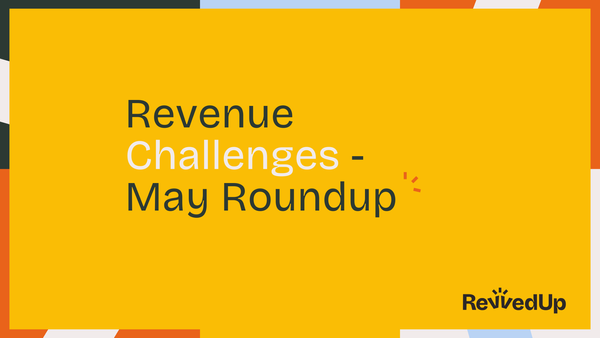Revenue Challenges - the May Roundup

Based on real conversations with revenue leaders across industries
May has been a fascinating month for conversations with revenue leaders. From our calls with prospects across industries—from entertainment SaaS to cybersecurity, fitness manufacturers to AI startups—we're seeing consistent patterns emerge.
Here's what's keeping revenue teams up at night right now.
The Capacity Crisis: Too Many Leads, Too Few Resources
The Problem: Multiple prospects are drowning in inbound volume but lack the capacity to handle it effectively.
One manufacturer we spoke to is generating 300 leads per week but their 6-person sales team can barely keep up with qualification, let alone proper nurturing.
As their head of marketing put it: "We're leaving a lot of money on the table because there are people that claim to say and we could reach back out to, but we just don't have the capacity right now."
The Pattern: Success is creating its own problems. Companies are generating demand but lack systems to convert it efficiently.
The Outbound Efficacy Collapse
The Reality Check: Traditional outbound isn't working like it used to.
A VP of Sales in the logistics space was brutally honest: "I've been calling manually... a good 30 to 40 dials before I get someone to answer. It's just a lot of voicemail."
Even when using proper techniques, connection rates are plummeting.
Another prospect noted: "Cold calling has been working okay for some people, but I'm not having the same experience... there's only so much you can do when people just don't answer their phones anymore."
The Pattern: Teams are throwing volume at the problem instead of improving quality, which only makes the noise worse for everyone.
Testing Without Results
The Problem: So many tools, not enough time and they’re just not delivering against expectations.
A digital marketing agency owner mentioned: "We tested automated tools for cold emails and LinkedIn DMs, but I'm always testing different things because I'm always on the lookout—not just for myself, but for my customers."
The Pattern: The plethora of choice is leading to a lot of time wasted on ineffective short-term solutions.
The Long Tail Opportunity Gap
The Insight: Companies have massive untapped revenue sitting in their existing customer bases.
A partnerships director at a major platform revealed: "We've got a lot of brands on the platform that we're just not engaging or nurturing at all... they're a real missed opportunity. They're on the platform but they're not being spoken to, and they've probably forgotten they're on the platform."
The challenge? Limited account management resources mean these valuable relationships go cold: "I don't think a lot of our outreach comes from email. They tend to do more things like intros through affiliate networks and events."
The Signal Detection Problem
The Challenge: Companies know prospects are showing interest but can't act on it effectively.
Multiple conversations revealed prospects struggling with signal identification:
- Website visitors who don't convert
- Social media engagement that doesn't translate
- Event attendance that doesn't lead to follow-up
As one prospect said: "We track if someone visits our website twice in 14 days—that means they're shopping, they're evaluating. We want to have those conversations, but we're not set up to act on those signals automatically."
The Research-to-Revenue Bottleneck
The Universal Pain Point: Everyone knows research matters, but no one has time to do it properly.
A technical growth leader admitted: "What's missing is something that helps with lead lists and getting the info... if someone's like 'oh, you've abandoned the conversion flow, thanks for this,' while here's something. There was a working on all of these... but we struggle to reach back out to them because we're constantly just wanting to meet new leads."
The pattern is clear: teams either skip research entirely (leading to generic outreach) or spend so much time researching that they can't reach enough prospects.
The Integration Nightmare
The Technical Reality: Revenue teams are drowning in disconnected tools.
Almost every conversation touched on integration challenges:
- CRM data that doesn't sync properly
- Multiple tools that don't talk to each other
- Manual processes that should be automated
One prospect summed it up: "We're using a combination of Cognism and HubSpot for outreach... these were tools that were brought in by our US team, and it's never been really challenged. I think I'd be open to shaking that part of the stack up."
The Personalization-at-Scale Paradox
The Expectation vs Reality Gap: Everyone wants personalization, but traditional methods don't scale.
A marketing leader explained their approach: "We have two marketing campaign managers, one SDR, and two sales executives... we're trying to do marketing campaigns, but it's all quite manual."
The challenge: How do you create meaningful, personalized outreach when you're dealing with hundreds or thousands of prospects?
Industry-Specific Insights
Cybersecurity & Technical Products
- Extremely long sales cycles (one prospect mentioned deals taking 18+ months)
- Highly technical buyers who demand deep expertise
- Challenge of explaining complex solutions simply
Marketplaces and Manufacturing
- Seasonal buying patterns that require careful timing
- Multiple stakeholders with different priorities
- Need for rapid response during peak booking periods
Professional Services
- Heavy reliance on referrals and relationships
- Difficulty scaling personal touch
- Challenge of demonstrating ROI for intangible services
What This Means for Revenue Leaders
These conversations reveal a fundamental shift in B2B sales. The old playbooks—more calls, more emails, more volume—aren't just ineffective; they're counterproductive.
The winners in 2025 will be the companies that can:
- Turn capacity constraints into competitive advantages through intelligent automation
- Replace spray-and-pray outbound with signal-based precision
- Unlock revenue from existing relationships, not just new logos
- Act on buyer signals in real-time, not days or weeks later
- Deliver research-backed personalization at scale
- Create seamless tech stacks that work together, not against each other
The revenue leaders having these conversations with us aren't looking for magic bullets. They're looking for systems that let their teams focus on what humans do best—building relationships and closing deals—while technology handles the research, insights, and orchestration that make those conversations possible.
If you’d like to consider a longer-term, strategic solution that helps to unlock team capacity, build a strong brand and create more pipeline value…we’d love to speak with you!
These insights come from real prospect conversations conducted in May 2025. Company names and specific details have been anonymised to protect confidentiality.
